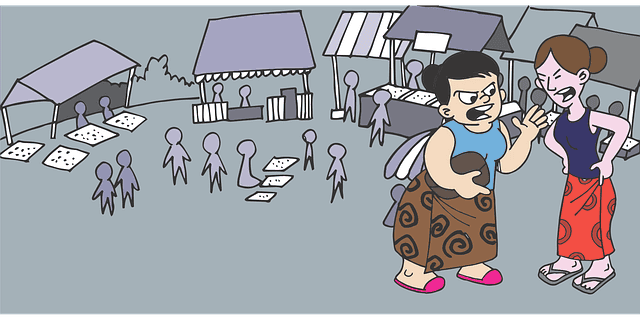When you’re a building owner, you can get caught in the middle of renter disputes. Here’s how to deal with bad neighbors and bring peace to your building.
Some tenants simply aren’t compatible. Oftentimes though, neighbor feuds stem from misunderstandings and miscommunications, causing bad situations to escalate. As an apartment building manager, you’ll occasionally need to deal with disputes between renters. Knowing how to deal with bad neighbors and disagreements is vital to maintaining a safe and happy community. Tenant conflict is not reserved for just your residential neighbors either, a conflict between two companies or between a local business and tenants can also arise.
There are many reasons why two entities clash. Arguments result from a simple misunderstanding or a perceived offense could be a catalyst. Common conflicts include parking issues, noise complaints or damaged property. More serious issues may arise due to prejudice, theft or even social issues involving mentally ill individuals.
When Neighborhood Disputes Become a Building Owner’s Problem…
Regardless of the reason for conflict, good property owners and business managers can’t allow negative situations to go unchecked. As a responsible business owner and manager, you’re often put in the middle of conflicts and tasked with facilitating the resolution of tenant disagreements. So, what’s the secret to learning how to deal with bad neighbors?
No matter how tempting it may be, you can’t avoid the problem and hope it goes away. Allowing an issue to go unresolved doesn’t work and will result in festering hostility between the parties involved. Fights escalate, causing larger issues like property damage, violence, illegal activity and situations necessitating the involvement of police.

However, it’s important to remember people generally prefer to resolve a problem rather than to go on fighting about it. Take the initiative to solve the issue before it negatively impacts your housing community. An environment of constant conflict is not conducive to a child-safe property and will likely discourage many stable, family renters. Tenants that don’t get along will ultimately leave your building with vacancies and even hurt your reputation.
Whether the issue is between neighboring tenants across a hall, two businesses in close proximity or a business and residents of the surrounding neighborhood, it all boils down to conflict resolution. At the core of disagreements, people are experiencing real feelings and emotions. Finding common ground while soothing hurt and upset feelings is the key to settling disputes. While every situation is different, there are some common ways to reach an understanding.
Here are 5 steps to conflict resolution you can take to diffuse a hostile situation before things get out of control:
How to Deal with Bad Neighbors: 5 Steps to Conflict Resolution
Step 1: Understand the Problem
Your first step should always be to stand back and attempt to understand the problem. It’s easy to take the side of the first person who approached you with a dispute, but there are always two sides to every story. Once a problem is brought to your attention, talk it out with both parties involved to get a complete overview of the situation.
It’s tough to know how to deal with bad neighbors, but active listening is the first step on the path to peace. People always appreciate it when they’re heard. Throughout the conflict resolution stage remain neutral–right now you’re researching.
Choosing sides in a tenant dispute will only add more anger and frustration to the situation, creating a larger issue. The best thing to do is listen to both sides while you gather information and document the problem. Recording actual notes about the incident is helpful. If at any time certain details become unclear or difficult to remember, you can reference your records to refresh your memory. If the situation truly escalates, the notes will be valuable for protecting your legal rights as well.
Step 2: Facilitate Discussion on Neutral Ground

The next step is to arrange a discussion between the two parties. Usually, people would prefer to go about their business peacefully, rather than remaining at odds. Living with bad blood towards your neighbors is no fun and no one wants that.
Chances are, both tenants can be reasoned with if they’re brought to a neutral location and asked to discuss their issues in a calm fashion. If they’re brought together with the intention to resolve their issues, they’re more likely to cooperate. Finding a spot to meet, away from the site of the incident will help quell anger; both parties won’t be faced with a reminder of their frustrations.
Schedule the meeting off-site and during a time when both parties are open. Early morning meetings and lunch hours, can result in a hasty outcome, where both parties feel rushed. However, it’s also important to schedule a clear end time–you don’t want the discussion to go in circles or to rehash and belabor the point.
The purpose of the discussion is to encourage each renter to explain what is really bothering them. A respectful and calm tone is a crucial part of a successful discussion. If one person feels threatened or taken advantage of, the situation may result in a shouting match. If either party feels they’re not being heard, the disagreement could continue to escalate.
Step 3: Mediate the Tenant Discussion
As a manager, you’re in a leadership role. When the two conflicting parties are brought together to work out a solution, you’ll often need to play the role of mediator. You’ll need to maintain the peace and relax everyone involved in the situation before it breaks into a screaming match… or worse, things get so out of hand you have to call the authorities. Conflict mediation and a calm approach will help avoid a nasty situation and help everyone get along.
There are a number of different approaches to mediation; one of the most common methods is to establish a set of rules both renters agree to before voicing their complaints. Be sure to emphasize the fact that neither person is there to verbally attack the other. They should both feel their position is valid and fully understand that they’re there to find a peaceful and productive resolution—not to bicker like children.
The most important rule of conflict mediation is that only one person is allowed to speak at a time. Listening is the key to facilitating a productive summit. One person should talk openly about why they’re unhappy while the other one listens quietly without interrupting. Then, the roles should reverse so the second person is able to voice their own frustrations.
Step 4: Shoot for Compromise
Once both neighbors have had the opportunity to calmly and openly discuss their side of the conflict, they’ll need to come to an agreement to prevent the issue from happening again. It’s very rare that one side is completely in the right while the other is completely in the wrong, so compromise is the name of the game.
When deciding on a compromise, your role as mediator is to highlight the importance of resolution. Bring the discussion back to the main purpose and remind everyone of the goal outcome. Reassure both renters that solving the issue will benefit them both mentally and physically; the stress of an ongoing unpleasant disagreement is not good for anyone.
After actively listening to the other person, both renters will likely have a better understanding of each other and the situation as a whole. They should be willing to work out an agreement beneficial for all the neighbors involved. As the manager, you may need to offer some solutions to help the tenants arrive at a satisfactory conclusion.
Step 5: Take Action to Finalize Your Agreement & Move On

While conflict resolution is sometimes a difficult process, if each renter agrees to hold up their end of the final compromise, the dispute will be resolved, or at least calmed, in most scenarios. Finding a compromise is all about rebuilding trust between the two parties and helping them discover common ground. Aim for a solution that works for everyone involved (including you, the building owner)!
As the building owner, there may be several people who will look to you for guidance in these negative situations and it is your job to set a good example. Learn to walk the walk of what you’re promoting. Remain neutral and avoid the urge to take sides or exchange commentary with either party after the issues have been resolved.
You may want to give the tenants an incentive to keep the peace. For example, if they’re able to remain conflict-free for a set amount of time, offer a small reward. The incentive doesn’t need to be monetary either. Gestures, such as recognition in the residential newsletter (if appropriate), a discount on a parking space, or even sending out thank you cards would do.
Acknowledgment will encourage the now-friendlier neighbors to uphold their deal, while also showing the other residents you respect each tenant equally.
Good Neighbors Go Beyond Good Fences
We’ve all heard that good fences make good neighbors. While it’s true that creating appropriate boundaries will help everyone get along, the philosophy is ultimately flawed. Building bridges is more important for keeping the peace.
Help your tenants find common ground and resolve their disputes in a mutually beneficial way. When neighbors share a space and have common territory, arguments will arise–it’s human nature. The important idea is how we learn from those arguments and create a space for everyone in the building.
Remember, if you want to have a great building that attracts renters and brings in a profit, you need to focus on creating a community. Everyone in your building is sharing something very personal–their home. Emotions are bound to rise up, because space is so important. Ultimately, we all want to live in a safe, comfortable, peaceful place.
Learning how to deal with bad neighbors is no easy task. As a building owner, you need to display diplomacy and patience to attract good tenants and keep all renters happy and harmonious. Your hard work will pay off, by showing your dedication to creating and maintaining a positive environment for everyone
Featured image courtesy of Flickr user Petra Bensted licensed under CC by 2.o. All other images via Pixabay – licensed via Public Domain.